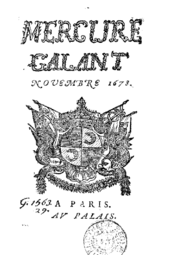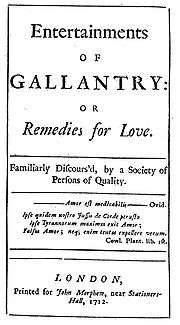Galant style
The galant style was an 18th-century movement in music, visual arts and literature. In Germany a closely related style was called the empfindsamer Stil (sensitive style).[1] Another close relative is rococo style. The galant style was drawn in opposition to the strictures of the Baroque style, emphasizing light elegance in place of the Baroque's dignified seriousness and high grandeur.[2][3]

November 1678, first issue of the Mercure Galant

Entertainments of Gallantry (1712)
Fashion
In fashion, galant featured perfumed handkerchiefs and powdered wigs for both sexes.[6] The fantastic exotic asymmetry of bizarre silk patterns were symptomatic of galant tastes.
References
- Daugherty, James F. "The Classical Period (1775-1825)". University of Kansas. Retrieved 2014-02-24.
- Hoffer, Charles (2012). Music Listening Today (4 ed.). Cengage Learning. p. 123. ISBN 9780495916147. LCCN 2010940572. Retrieved 2014-02-24.
- Bachus, Nancy, ed. (2006-07-01). The Baroque Piano: The Influence of Society, Style, and Musical Trends on the Great Piano Composers. Alfred Music. p. 69. ISBN 0739042955. Retrieved 2014-02-24.
- "Style Galant". Lcsproductions.net. Retrieved 2014-02-24.
- White, Chappell (1994). From Vivaldi to Viotti: A History of the Early Classical Violin Concerto. Gordon and Breach. p. xiv. ISBN 2881244955. Retrieved 2014-02-24.
- Daniel, Ralph Thomas. "Western music: The sonata and concerto". Encyclopædia Britannica. Retrieved 2014-02-24.
External links
![]()
This article is issued from Wikipedia. The text is licensed under Creative Commons - Attribution - Sharealike. Additional terms may apply for the media files.